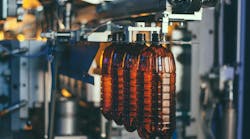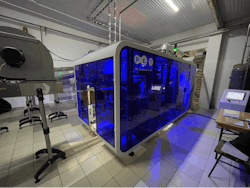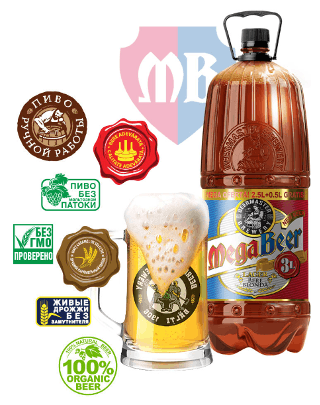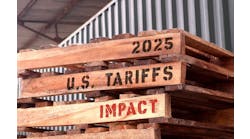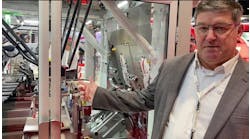PET Technologies customizes blow-molding machine for Beermaster
Craft brewing company Beermaster in Balti, Moldova, has been in business since 1906, brewing beer and a handful of other beverages, such as energy drinks, soft drinks, bottled cocktails and cider. Beermaster’s most popular bottled beers—lagers, ales, IPAs and others, including fruit beers— come in containers ranging from 300-milliliter to 3-liter glass and polyethylene terephthalate (PET) bottles.
The rising interest in craft beers has driven demand for Beermaster’s products overall and has also increased demand for unique bottle shapes and sizes. At the same time, packaging has evolved significantly to meet consumer preferences and environmental concerns. Customers now expect eco-friendly packaging without compromising product quality.
Get your subscription to Control Design’s daily newsletter.
Breweries such as Beermaster have shifted toward lightweight, recyclable packaging materials like PET, which also offers durability and quality, in addition to sustainability. All these trends have driven Beermaster to more flexible production equipment, which it found with PET Technologies and its fully automated blow-molding machine, APF-Max 4L (Figure 1).
Beermaster was previously reliant on semi-automatic machines that ran seven different blow molds, and the machines faced frequent production halts. Mold changes were time-consuming, and the older machines had consistent maintenance issues, which all caused production bottlenecks. At the time, the brewery had a production goal of 4,000 bottles per hour and was having trouble meeting that goal regularly.
In 2023, Beermaster started working with PET Technologies to upgrade to a new customized fully automatic machine, capable of producing PET bottles in five different sizes with an output of 7,000 bottles per hour.
Sustainability and energy efficiency
PET Technologies was founded in 1999 and employs around 200 people, including 35 engineers—12 electrical, 12 mechanical and 11 software and automation specialists. The machine builder specializes in designing and manufacturing blow-molding equipment and complete solutions for the plastics packaging industry.
PET Technologies primarily designs two-stage blow-molding machines for PET bottle production and blow molds, serving the food and beverage, pharmaceutical, household chemical and cosmetics industries. Approximately 60% of the machines it sells are standard, and the rest are custom machines, spanning production in more than 60 countries, including Europe, Asia, Africa and the Americas.
The custom machines are typically designed for manufacturers that require specific bottle applications, shapes, sizes or production environments. The typical timeframe from design to machine delivery is six to eight months for fully electric machines, and pneumatic blow-molding machines can be delivered in less time. Custom builds can take longer, depending on the complexity and additional features, such as unique bottle shapes, embossing or different bottle sizes, which can all affect how the machine handles the preforms and controls the blow-molding process.
“This is a common request from manufacturers, especially those looking to differentiate their products in competitive markets. To accommodate these requests, we design modular systems that allow for easy mold changes and fine-tuned machine settings to ensure that brand-specific designs are produced efficiently and consistently,” says Roman Gora, head of the R&D department at PET Technologies.
“Requirements to make a blow-molding machine compatible with molds of other brands are very common especially among PET bottle makers,” Gora says. “This is a common trend for the Americas market.”
He says sustainability and energy efficiency are also driving machine trends. “There is a growing demand for machines that reduce material waste and operate with reduced energy consumption,” Gora says. The use of recycled PET (rPET) is also rising. “Machines need to adapt in order to process rPET without compromising quality,” he adds. “Now 90% of PET Technologies’ machines running in the Americas and Europe process 100% rPET preforms. The demand for returnable U.S. 5-gallon and up to 2-liter bottles is also growing drastically.”
PET Technologies has developed four generations of PET stretch blow-molding machines, with the latest APF-Max series released in 2017. Gora says there is growing interest in fully electric APF-Max blow molders globally.
“The key drivers are flexibility, faster production rates with reduced energy consumption, lightweight packaging and sustainability. Automation has played a key role in enhancing precision and reducing manual intervention. Modern machines now feature automated controls, robotic handling and smart sensors, allowing for quick changeovers, higher output and minimal downtime,” Gora says.
Fully automatic blow-molder machine
For Beermaster, the upgrade to a fully automatic machine met its needs for sustainability and quality. The brewery began collaborating with PET Technologies in 2023 to install a customized version of the APF-Max 4L blow-molder machine, designed to produce a wide range of bottles. The machine was modified to handle unique bottle shapes and volumes for Beermaster’s product line.
Another important part of the machine design was the ability to tailor the bottle design to incorporate Beermaster’s branding and logo on each bottle, strengthening brand recognition and visual appeal (Figure 2).
The biggest bottlenecks for Beermaster were slow production speeds and frequent manual interventions for format changes. It’s time-consuming for operators to switch between bottle sizes, and the manual processes increased the risk of inconsistencies in bottle quality. With a wide variety of beverage products, Beermaster switches between bottle sizes frequently, on average multiple times per week.
The quick change bottle format process on the APR-Max 4L was a game changer for the brewery. “The quick bottle format change process is designed to minimize downtime when switching between different bottle designs or sizes. On the APF-Max series, it involves the use of modular molds and automated adjustments to the heating and blowing systems. Operators can replace molds and fine-tune machine settings in 20 minutes,” Gora says.
The APF-Max 4L is also designed with several energy-saving features. “The near-infrared (NIR) heating system significantly reduces power consumption compared to traditional infrared systems by targeting only the PET preforms. This results in up to 30% less energy usage. The machine is also compatible with rPET and is built to reduce material waste through precise control of the molding process. Additionally, the machine’s modular design enables flexible production, reducing downtime and further enhancing overall energy efficiency,” Gora says.
PET is a thermoplastic polymer belonging to the polyester group, and heat will cause softening and deformation. “PET is recyclable because it can be melted down and reformed without significant degradation in quality,” Gora says.
In bottle manufacturing, a heated PET preform is passed to a mold and takes that shape. Traditionally, infrared radiation lamps do the heating, but NIR was found to work better with PET. In PET stretch blow-molding machines with NIR, the heating process is faster so it reduces energy consumption and can use a smaller heater. The equipment also has a smaller overall footprint.
“NIR heating technology is crucial because it allows more efficient and targeted heating of the preforms during the blow-molding process, which is especially important when working with recycled PET. The precision of NIR heating ensures that rPET preforms are heated uniformly, improving the quality of the final bottle and reducing energy consumption,” Gora says. PET Technologies began incorporating NIR technology into its machines in 2017.
PET Technologies says there is growing demand from its clients for more energy-efficient blow-molding machines. “Several factors are driving this trend, including stricter environmental regulations, rising energy costs and increasing consumer awareness of sustainability. Many companies are also setting ambitious corporate sustainability goals, leading them to seek out machinery that reduces energy consumption, lowers carbon footprints and enables the use of recycled materials,” Gora says.
